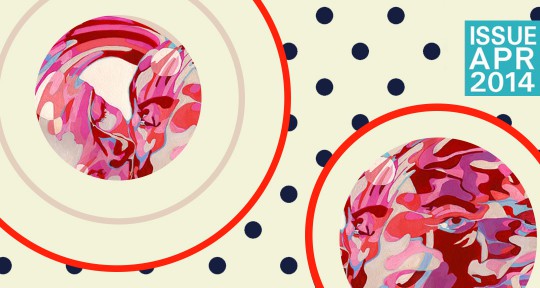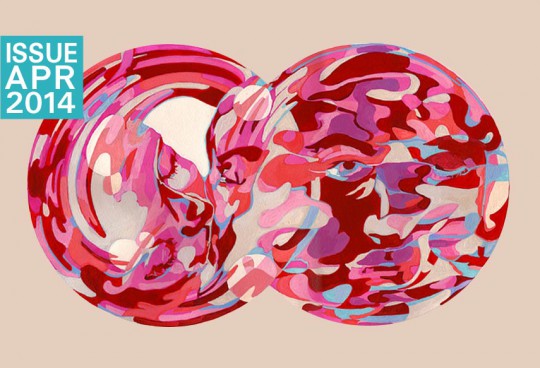By April 2014, Asymptote has snowballed into a team of 60. Though I never signed up to lead so many team members, expansion is a matter of inevitability for a magazine that publishes new work from upwards of 25 countries every quarter (and that prides itself on editorial rigor). After all, if Asymptote section editors only relied on personal connections, it would only be a matter of time before available leads dried up. There is simply no substitute for local knowledge and, more importantly, local networking, since getting the author’s permission to run or translate his or her work is often the hardest part. (For the English Fiction Feature in the Spring 2014 issue alone, I sent solicitations, directly or indirectly, to Rohinton Mistry, Chimamanda Ngozi Adichie, Jhumpa Lahiri, Ha Jin, Chang-rae Lee, Tash Aw, Akhil Sharma, and Tao Lin—all in vain alas.) An entire book could probably be written about how Asymptote wooed author X or translator Y or guest artist Z to come on board as contributor. One particularly memorable (and—I assure you—not representative of the way we operate) episode comes to mind: When her phone call to an author was intercepted and met with a flat rejection by his secretary, a particularly persistent team member signed up for a two-day workshop conducted by said author. At an intermission, she casually makes the ask. The author agrees to discuss the matter the next day, at a restaurant. During dinner, our team member is subjected to intensive grilling before permission is finally granted to run and translate his work. Here to recount how we managed to ask Nobel laureate Herta Müller to come on board as contributor (and to give us permission to translate her moving essay into 8 additional languages) is editor-at-large Julia Sherwood:
I was invited to join the Asymptote team as editor-at-large for Slovakia after volunteering to translate into Slovak Jonas Hassen Khemiri´s Open Letter to Beatrice Ask, which appeared in 20 languages in the Spring 2013 issue of Asymptote. The journal had only been around for two years, but it had already established a reputation for featuring translations from a staggering array of languages and authors who had never been published in English. Slovak, my native language, had yet to make an appearance, so I immediately set out to source suitable texts in high-quality translations. My first success came when “Where to in Bratislava”, a story by Jana Beňová and translated by Beatrice Smigasiewicz, was chosen for the Winter 2014 issue. Soon after that I managed something of a scoop: bringing to Asymptote “The Space Between Languages,” an essay by Nobel laureate Herta Müller.
But before explaining how this came about, I should first mention that—like many others born in what used to be Czechoslovakia—I grew up reading Czech writers alongside Slovak ones and consuming Czech translations of world literature. Because of this close affinity with Czech culture, and because Asymptote hasn’t had an editor-at-large for the Czech Republic, I have effectively covered my second home country right from the beginning of my association with the journal. A Czech writer I was particularly keen to introduce to Asymptote’s readers was Radka Denemarková, whose work has been translated into nine languages but still remains largely unknown in the English-speaking word.
Throughout her writing—which includes novels, plays, and essays on literature, philosophy, and current affairs—Denemarková tirelessly champions the oppressed by tackling difficult and often controversial themes such as social exclusion, discrimination against minorities, domestic violence, child abuse and rape, as well as historical injustice. She is also the only Czech writer to have won the country’s prestigious Magnesia Litera prize in three different categories. The first, in fiction, came in 2007 with the novel Money from Hitler, the harrowing story of a Holocaust survivor who becomes victim of racist, anti-Semitic, and political prejudice after the war. (It is her only book to be published in English, in Andrew Oakland’s translation, but sadly it did not receive the attention it deserves and is now almost impossible to find.) Two years later she won her second Magnesia Litera Prize, in non-fiction, for her biography of playwright and dramaturg Petr Lébl. And in 2011 she won once more, this time for her translation of Herta Müller’s novel Atemschaukel (known in English as The Hunger Angel).
Since then Denemarková has translated three further books by Müller, and this connection seemed to offer a window of opportunity. Maybe the Nobel laureate would be willing to write a short piece introducing her Czech translator and fellow-writer for Asymptote´s Writers on Writers section, designed to showcase lesser-known writers by their more famous colleagues? We approached Müller and she readily agreed, but since she was in poor health at the time she suggested that we use the text of a speech she had given in 2012 at the Goethe-Institut in Prague. Her essay celebrates the art of translation, which she defines as “looking at words in order to see how those words see the world” and “an art in its own right.” She continues:
For translation doesn’t mean just replacing, i.e., finding a familiar word in your own language to substitute for a word in a foreign language. The word has to match, which is much more difficult. A translator has to recreate the sound of the original. The art of translation is looking at words in order to see how those words see the world. Translation requires an inner urgency that will make that which is different as close to the original as possible. Finding this eye-to-eye contact is extremely difficult. It is a great art.
I had the honour of translating this fantastic piece from German into English, after which our editor-in-chief reached out to Asymptote contributors and editors-at-large to commission translations into nine more languages, giving this text the widest reach in our Spring 2014 issue. In “On Translating Herta Müller,” a companion piece, Denemarková talks about translating Müller in her characteristically warm, evocative style:
I translate the way I hope other translators translate my own books—by hugging and caressing them, by putting my finger on the emotion and the rhythm. It is not about literal translation but rather about achieving an effect in the target language that is the same as that in the source language. I sometimes think books should be translated only by writers, for they have a different way of seeing things, they see into each other’s kitchens, they won’t be ‘bamboozled’ and fooled, while at the same time they approach the job with humility and respect its integrity.
Two years later, a sample of Radka Denemarková’s own writing—an extract from her novel A Contribution To the History of Joy—was featured in ‘Translation Tuesday’ on the Asymptote blog and in The Guardian.
Readers of the Spring 2014 issue were afforded another, equally fascinating glimpse into a creative translator’s art in David Bellos’ review of Barbara Wright’s translation of Raymond Queneau’s Exercices de style. It is a magnificent feat of verbal gymnastics since, as Bellos explains:
The work consists of 99 variations, ranging in length from a paragraph to three pages, on the same trivial, futile story of a man who treads on toes in a Paris bus and then some time later gets upbraided for having his overcoat button in the wrong place. The variations play with a range of different literary devices, from rhetorical techniques such as homeoteleuton, apocope, and synchysis, to poetical forms (sonnet, haiku, alexandrines), games with language register (pompous, vulgar, bureaucratic), and with languages themselves (Italianisms, sound-translation into English), and to changes in effect (reactionary, apologetic, hesitant).
While other pieces, including Aamer Hussein’s review of Rashid Jahan’s collected writing, reflect on the art of translation as it is traditionally understood, a radically different take that involves the convergence of visual art and literature appears in Script, a set of videos by the Irish artist Grace Weir. In the ensuing Q&A she takes this idea even further by turning to geometry:
In Euclidean geometry, a translation is a function that moves every point a constant distance in a specified direction. A translation can also be interpreted as the addition of a constant vector to every point, or as shifting the origin of the coordinate system. The Cubists used the concept of translation to unfold the plane of the surface of a painting and reject the conventions of perspective and representation in painting.
It is a nice allusion to Asymptote’s name, which comes from a term in geometry: two lines that get ever closer to each other yet never converge completely, just like a translated text is never fully identical with the original but rather represents a work of art in its own right.
Along with reflections on translation, the theme of diaspora also unifies several contributions in this April 2014 issue. Herta Müller closes her essay with a description of parting with a friend before going into exile that resonates particularly strongly with my own experience, as does the extract from Vladimir Vertlib´s Way Stations (trans. David Burnett), a wonderful piece of sensitive storytelling about the confusion and displacement experienced by a young Russian émigré in Italy. Diaspora and displacement are always implicitly present in Jonas Hassen Khemiri’s work, and they are represented in this issue by a haunting extract from his play, I Call My Brothers, about suspicion and surveillance that is just as relevant today, when populists all over the world fan hatred and resentment of refugees and immigrants, as it was in 2014.
Julia Sherwood has been an editor-at-large at Asymptote since May 2013.
*****
Read more from our #30issues30days showcase:


